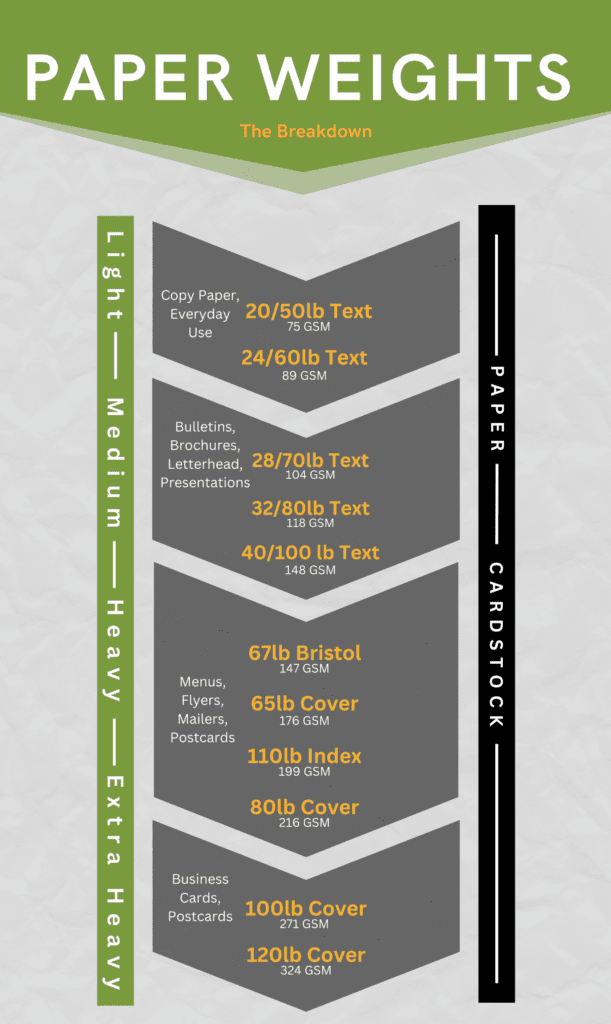Understanding Paper Weights: A Complete Guide to Choosing the Right Paper for Your Prints
Paper weights can be one of the trickiest aspects of choosing the right paper for your printing project. With various weight scales, terms, and measurements, it’s easy to feel overwhelmed. But once you break it down, it becomes much more straightforward—and even exciting when you realize the level of control you have over the quality and appearance of your printed materials!
THE BREAKDOWN
Let’s start with the concept of Basis Weights, which is the most commonly used way of measuring paper weight in the United States.
- When you look at the weight of paper listed in pounds (lbs), what you’re actually seeing is the weight of 500 sheets (a ream) of that paper in its basic, uncut size. This is why the weight can be different for different types of paper, even if the actual sheet size you’re holding is the same.
For thin paper, there are two common Basis Weights you’ll encounter: Bond and Text.
- Bond paper is what most of us think of as everyday office paper, often used for things like letterhead, invoices, or general documents. Text paper is a bit heavier and is used in things like booklets or brochures. These two Basis Weights are often used interchangeably, similar to how Celsius and Fahrenheit can both describe the same temperature.
- For example, you might see a paper labeled as 24 lb. Bond or 60 lb. Text, and these could actually be the same paper, just described using different Basis Weights.

When we move into thick paper (commonly referred to as cardstock), the Basis Weights change.
Here, you’ll see three main categories: Bristol, Cover, and Index.
- These Basis Weights are not interchangeable, and this is where a lot of confusion happens. A common mistake is assuming that a higher number always means thicker or heavier paper.
- However, because these scales are independent of each other, this is not the case.
- For example, 80 lb. Cover is actually thicker and heavier than 110 lb. Index—something that surprises many people who are new to understanding paper weights!
Another system for measuring paper weight is the metric system, where paper is measured in GSM, or Grams per Square Meter.
GSM measures the actual weight of a square meter of the paper, and it’s a much more straightforward measurement than Basis Weight. The lower the GSM number, the lighter and thinner the paper; the higher the GSM, the thicker and heavier the paper. For instance, a 90 GSM paper would be lightweight and typically used for things like letters, while a 300 GSM paper would be much heavier and better suited for postcards or business cards. Many printers and digital devices will categorize paper by GSM, so you may need to adjust your printer settings based on the GSM of the paper you’re using.
POWER IN VARIETY
The variety of paper weights available allows you to tailor your choice to the specific needs of your project, whether you're printing flyers, brochures, business cards, or custom invitations. Understanding the relationship between these different paper weight systems will help you make more informed decisions and ensure you achieve the professional, high-quality results you're aiming for with each print.
Ultimately, the key takeaway is to be mindful of the type of Basis Weight you're dealing with and not just assume that a higher number always means thicker or heavier paper. By understanding the difference between Bond, Text, Bristol, Cover, and Index, as well as incorporating GSM where appropriate, you can choose the perfect paper for your print job and impress your clients with the finished product.
NEED A VISUAL?
Our paper weight chart is an essential tool for selecting the right paper for any project. This chart lists paper weights in both pounds (lbs) and GSM (Grams per Square Meter), offering a dual system of measurement to help you better understand and compare paper thickness and weight. Arranged from heaviest to lightest, the chart not only provides the corresponding GSM for each paper weight but also outlines typical uses for each type of paper. For instance, heavyweight papers like 100 lb. Cover (271 GSM) are ideal for business cards and postcards, while lighter papers like 24 lb. bond/60lb text (89 GSM) are better suited for everyday printing, such as office documents. Whether you're choosing paper for marketing materials, menus, or brochures, this chart helps simplify the process by highlighting how each paper weight performs for different purposes. Make sure you download and print for your next purchase!
Download Paper 101 Today!
Looking to dive deeper into the world of paper and really know all the basics? Check out our brand new paper buying guidebook Paper 101: A Comprehensive Guide on Buying the Right Paper.
What You’ll Learn in Paper 101
Paper Weights ,Paper Sizes, Coated vs. Uncoated Paper, Brightness & Thickness, Tips & Tricks for Printing, Specialty Options: Perforation & Paper Grain, and so much more!
Download the guidebook today and start making smarter, more confident paper choices for all your printing needs.
OH AND DID WE MENTION IT'S FREE?!
Download Now <------and unlock the full potential of your printing projects!

